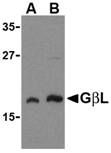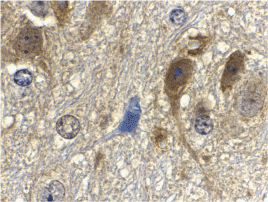Catalog#:3495
GbetaL (G protein beta protein subunit-like) is a member of a signaling pathway that regulates mammalian cell growth in response to the presence of nutrients and growth factors (1). It binds to the kinase domain of TOR (Target of rapamycin, also known as mTOR), an evolutionarily conserved serine/threonine kinase that regulates cell growth and cell cycle through its ability to integrate signals from nutrient levels and growth factors (reviewed in 2). Rapamycin inhibits TOR resulting in reduced cell growth and reduced rates of cell cycle and cell proliferation (reviewed in 3). TOR is normally associated with GbetaL and an additional regulatory protein RAPTOR, allowing TOR to control protein biosynthesis (3). The binding of GbetaL to TOR stimulates TOR’s kinase activity towards downstream proteins such as RPS6K (ribosomal protein S6 kinase) and the translation factor 4E-BP1 which leads to increased protein translation and cell growth (3).
Additional Names: GBL, G beta protein subunit-like

Description
Left: Western blot analysis of GbL in human brain cell lysate with GbL antibody at (A) 1 and (B) 2 µg/ml.
Below: Immunohistochemistry of GbL in mouse brain tissue with GbL antibody at 10 µg/ml.
Other Product Images
 Source:GbL antibody was raised against a 14 amino acid peptide from near the carboxy-terminus of human GbL.
Source:GbL antibody was raised against a 14 amino acid peptide from near the carboxy-terminus of human GbL.Purification: Affinity chromatography purified via peptide column
Clonality and Clone: This is a polyclonal antibody.
Host: GBL antibody was raised in rabbit.
Please use anti-rabbit secondary antibodies.
Immunogen: Human GbL / G beta protein subunit-like Peptide (Cat. No. 3495P)
Application: GbL antibody can be used for the detection of GbL by Western blot at 1 µg/ml.
Tested Application(s): E, WB, IHC
Buffer: Antibody is supplied in PBS containing 0.02% sodium azide.
Blocking Peptide:Cat. No. 3495P - GBL Peptide
Long-Term Storage: GBL antibody can be stored at 4ºC, stable for one year. As with all antibodies care should be taken to avoid repeated freeze thaw cycles. Antibodies should not be exposed to prolonged high temperatures.
Positive Control:
1. Cat. No. 1303 - Human Brain Tissue Lysate
2. Cat. No. 1403 - Mouse Brain Tissue Lysate
Species Reactivity: H, M, R
GI Number: 30411038
Accession Number: AAH52292
Short Description: a member of the TOR signaling pathway
References
1. Kim D-H, Sarbassov DD, Ali SM, et al. GbetaL, a positive regulator of the Rapamycin-sensitive pathway required for the nutrient-sensitive interaction between Raptor and mTOR. Mol. Cell 2003; 11:895-904.
2. Shamji AF, Ngheim P, and Schreiber SL. Integration of growth factor and nutrient signaling: implications for cancer biology. Mol. Cell 2003; 12:271-80.
3. Fingar DC and Blenis J. Target of rapamycin (TOR): an integrator of nutrient and growth factor signals and coordinator of cell growth and cell cycle progression. Oncogene 2004; 23:3151-71.

No comments:
Post a Comment